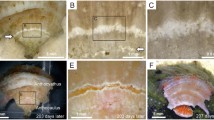Abstract
Recent studies suggest a diurnal periodicity in the deposition of fusiform crystals by scleractinian corals. In order to check whether this is universally true in the Scleractinia, the surface structure of skeletons of Galaxea fascicularis (L.), collected at 3 h intervals over 1 day was observed with a scanning electron microscope. Fusiform crystals 0.3–3 μm wide and 0.5–5 μm long were found on the growing edges of septa of polyps collected at different times of day. There was no apparent diurnal change in the mean diameter of fusiform crystals. The size distributions of these crystals were almost the same by day (1200 h) and at night (2400 h). Small fusiform crystals which appeared to have been newly deposited were observed on septa collected both during the day and at night. The present study suggests that fusiform crystals are deposited continuously with no diurnal rhythm in G. fascicularis.
Similar content being viewed by others
References
Barnes DJ, Crossland CJ (1980) Diurnal and seasonal variations in the growth of a staghorn coral measured by time-lapse photography. Limnol Oceanogr 25:1113–1117
Chalker BE (1983) Calcification by corals and other animals on the reef. In: Barnes DJ (ed) Perspectives on coral reefs. Australian Institute of Marine Science, Townsville, pp 29–45
Gladfelter EH (1982) Skeletal development in Acropora cervicornis: I. Patterns of calcium carbonate accretion in the axial corallite. Coral Reefs 1:45–51
Gladfelter EH (1983) Skeletal development in Acropora cervicornis. II. Diel patterns of calcium carbonate accretion. Coral Reefs 2:91–100
Hidaka M (1988) Surface structure of skeletons of the coral Galaxea fascicularis formed under different light conditions. Proc 6th Int Coral Reef Symp 3:95–100
Hidaka M (1991) Fusiform and needle-shaped crystals found on the skeleton of a coral, Galaxea fascicularis. In: Suga S, Nakahara H (eds) Mechanisms and phylogeny of biomineralization in biological systems. Springer, Berlin Heidelberg New York, pp 139–143
Johnston IS (1980) The ultrastructure of skeletogenesis in hermatypic corals. Int Rev Cytol 67:171–214
Le Tissier MDA (1988) Diurnal pattern of skeleton formation in Pocillopora damicornis (Linnaeus). Coral Reefs 7:81–88
Strömgren T (1987) The effect of light on the growth rate of intertidal Acropora pulchra (Brook) from Phuket, Thailand, lat. 8° N. Coral Reefs 6:43–47
Wainwright SA (1964) Studies of the mineral phase of coral skeleton. Exp Cell Res 34:213–230
Wells JW (1956) Scleractinia. In: Moore RC (ed) Treatise on invertebrate paleontology, part F, Coelenterata. Geological Society of America, University of Kansas Press, pp 328–477
Wise SW (1972) Observations of fasciculi on developmental surfaces of scleractinian coral exoskeletons. Biomineralization 6:160–175
Author information
Authors and Affiliations
Rights and permissions
About this article
Cite this article
Hidaka, M. Deposition of fusiform crystals without apparent diurnal rhythm at the growing edge of septa of the coral Galaxea fascicularis . Coral Reefs 10, 41–45 (1991). https://doi.org/10.1007/BF00301906
Accepted:
Issue Date:
DOI: https://doi.org/10.1007/BF00301906




